The Men
Behind the Mission Style
by
Bob Brooke
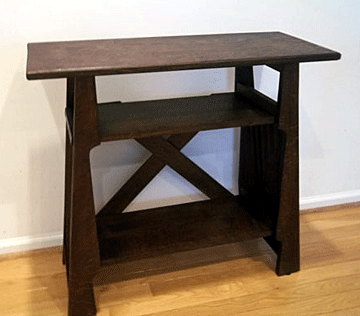 Mission furniture originated as a style in the late 19th Century. It all
began with a chair made by A.J. Forbes in 1894 for San Francisco's
Swedenborgian Church. Joseph P. McHugh of New York, a furniture
manufacturer and retailer, copied these chairs and by 1898 offered a
line of his own which he called “Mission” furniture. Though the word
mission refers to the Spanish missions in California, the design of
Mission style furniture had little to do with the original furnishings
of these missions. Mission furniture originated as a style in the late 19th Century. It all
began with a chair made by A.J. Forbes in 1894 for San Francisco's
Swedenborgian Church. Joseph P. McHugh of New York, a furniture
manufacturer and retailer, copied these chairs and by 1898 offered a
line of his own which he called “Mission” furniture. Though the word
mission refers to the Spanish missions in California, the design of
Mission style furniture had little to do with the original furnishings
of these missions.
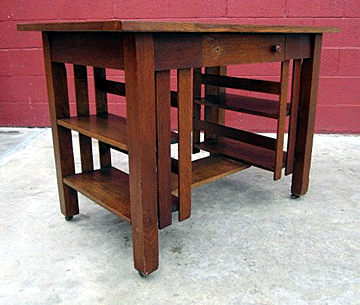 Mission style became increasingly popular after the Pan-American
Exposition in Buffalo, New York, in 1901, and became associated with the
American Arts & Crafts Movement. However, while all Mission furniture
can be considered Arts & Crafts furniture, not all Arts & Crafts
furniture is in the Mission style. Mission style became increasingly popular after the Pan-American
Exposition in Buffalo, New York, in 1901, and became associated with the
American Arts & Crafts Movement. However, while all Mission furniture
can be considered Arts & Crafts furniture, not all Arts & Crafts
furniture is in the Mission style.
Mission style is a design that emphasizes simple horizontal and vertical
lines and flat panels that accentuate the grain of the wood, usually
oak. People wanted relief from the excesses of Victorian times and the
influx of mass-produced furniture from the Industrial Revolution. This
was plain furniture that was upright, solid, and suggestive of entirely
handcrafted work, though most makers of Mission furniture used machines
augmented by handworking techniques.
Many designers and companies played an important role in the development
of the Mission style, including Gustav Stickley, L. & J.G. Stickley, and
Charles Limbert.
Gustav Stickley
As the founder and subsequent leader of the American Arts & Crafts
Movement, Gustav Stickley influenced over 50 other companies to follow
him and created an indelible style of furniture that has seen a
resurgence today. His original furniture, produced by the Gustav
Stickley Company in Eastwood, New York, an uncomfortable hybrid of
Victorian excess and Arts & Crafts simplicity. After publishing a
catalogue of his pieces, he became widely known. But interior design
trends were changing quickly. So the following year, he changed the name
of his company to United Crafts.
 He chose a joiner's compass as his trademark and by 1902 was making
simple, solid furniture in the style of William Morris, the founder of
the Arts & Crafts Movement in Britain, using American white oak. He
styled his furniture after the relatively new Mission style that had
began a few years earlier. He chose a joiner's compass as his trademark and by 1902 was making
simple, solid furniture in the style of William Morris, the founder of
the Arts & Crafts Movement in Britain, using American white oak. He
styled his furniture after the relatively new Mission style that had
began a few years earlier.
Stickley liked the look and feel of heavy, quarter-sawn oak. But instead
of staining the wood, he fumed it with ammonia to give it a dark finish.
Some of his pieces had a broad "tiger-striped" grain, keyed-through
tenons, long arched corbels, and circular pins securing major joints. A
few tables and chairs have "reversed tapered" legs, where the legs
broaden as they extend downwards.
Gustav Stickley called his line Craftsman Furniture, after the home
improvement magazine,
The Craftsman, which he began publishing in 1901.
In his 1909 catalogue, he wrote: "I had no idea I was attempting to
create a new style, but merely tried to make furniture which would be
simple, durable, comfortable, and fitted for the place it was to occupy
and the work it had to do. It seemed to me that the only way to do this
was to cut loose from all tradition and to do away with needless
ornamentation, returning to the plain principles of construction and
applying them to the making of simple, strong, comfortable furniture."
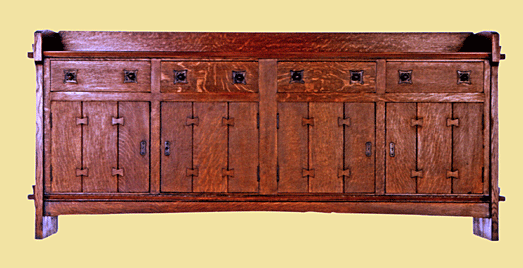
The following year, Stickley changed his company’s name once again to
Craftsman Workshops to reflect the name of his furniture line. Within a
year, his furniture got simpler and lighter in weight and color.
He discovered that his modified designs were cheaper to produce, so he
could sell them at affordable prices, making them available to the
middle-class buyers. His workshop combined the latest technology with
hand-finishing techniques, which helped to maintain the affordability of
his pieces.
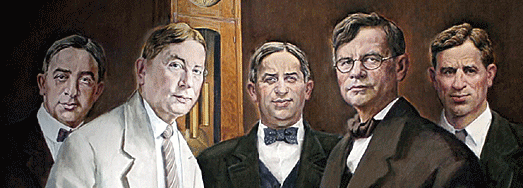
Gustav was the eldest of five brothers, born in Wisconsin to German
migrant parents. All worked individually and occasionally partnered with
each other and other cabinetmakers. They first made furniture at their
uncle's factory in Brandt, Pennsylvania, in 1877. While Gustav was a
visionary, Albert's strength was in marketing, Charles excelled in
production, Leopold was a successful manager, and John was a great
salesman—the best in his day. But they had problems working together,
and so rather than build what was potentially an invincible family firm,
they each set up their own companies which achieved only modest success.
Unfortunately, Gustav’s competition, changing design trends, and the
decision to open a store in New York City forced him into bankruptcy in
1915.
L. & J.G. Stickley
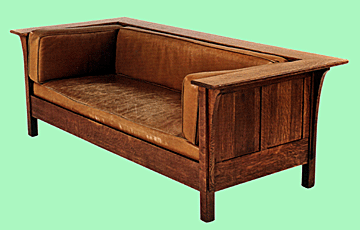 The two youngest of the five Stickley brothers, Leopold and John George,
worked for their older brothers before setting up on their own. Leopold,
who had been working as a foreman for Gustav, was the first to leave. He
founded the Onondaga Workshops in 1904. Later that year John George, who
had been working with Albert, joined him, and the enterprise in
Fayetteville, a suburb of Syracuse, New York, became L. & J.G. Stickley. The two youngest of the five Stickley brothers, Leopold and John George,
worked for their older brothers before setting up on their own. Leopold,
who had been working as a foreman for Gustav, was the first to leave. He
founded the Onondaga Workshops in 1904. Later that year John George, who
had been working with Albert, joined him, and the enterprise in
Fayetteville, a suburb of Syracuse, New York, became L. & J.G. Stickley.
The brothers showed their first furniture line at a trade show in Grand
Rapids, Michigan, in 1905 where they promoted it as "simple furniture
built along mission lines."
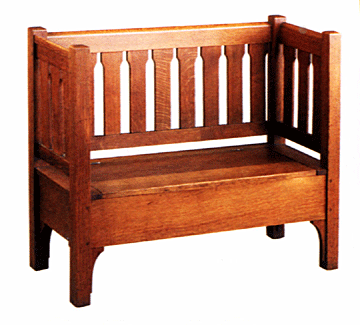 Like their brothers, L. & J.G. Stickley used high-quality local woods
and traditional furniture construction techniques to make pieces
inspired by those of Gustav. But they weren’t purists like him and made
most of their furniture by machine. Rather than employ the dark, fumed
finishes used by Gustav, they chose stains that allowed the grain of the
wood to show through. Like their brothers, L. & J.G. Stickley used high-quality local woods
and traditional furniture construction techniques to make pieces
inspired by those of Gustav. But they weren’t purists like him and made
most of their furniture by machine. Rather than employ the dark, fumed
finishes used by Gustav, they chose stains that allowed the grain of the
wood to show through.
In 1906 the company name changed to Handcraft, and in 1912, it changed
again to The Work of L. & J.G. Stickley. In 1918,following Gustav's
bankruptcy, L. & J.G. Stickley took over his Craftsman Workshops and
combined it with its own successful Mission furniture line.
Charles Limbert
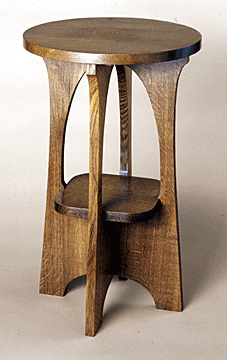 Charles P Limbert, the son of a furniture dealer and cabinetmaker,
founded the Limbert Furniture Company in 1894 in Grand Rapids, Michigan,
which at the time was the center of American furniture making. Limbert
began by making Mission style furniture, but In 1902, he added a Dutch
Arts & Crafts line inspired by the traditions of the Dutchmen who lived
nearby and worked there. Charles P Limbert, the son of a furniture dealer and cabinetmaker,
founded the Limbert Furniture Company in 1894 in Grand Rapids, Michigan,
which at the time was the center of American furniture making. Limbert
began by making Mission style furniture, but In 1902, he added a Dutch
Arts & Crafts line inspired by the traditions of the Dutchmen who lived
nearby and worked there.
From 1904 until around 1910 Limbert’s factory developed rectilinear,
well-proportioned pieces made in high-quality materials and using
machines as well as traditional hand-tool techniques. Though his
furniture didn’t have the exceptional finish of those of Gustav Stickley,
they were still fine examples of American Arts & Crafts furniture.
Though Limbert designed pieces similar to his competitors, including
chairs, desks, and lamp tables from solid oak but sometimes mahogany, he
employed repeating cutout squares, rectangles, triangles, or hearts to
give his pieces flare. Each of his pieces wore the branded mark of a
cabinetmaker working at his bench,and he sold them through mail order
catalogues. (Read “The Other Arts & Crafts Designer.”)
<
Back to Antiques Articles
Next Article >
|
